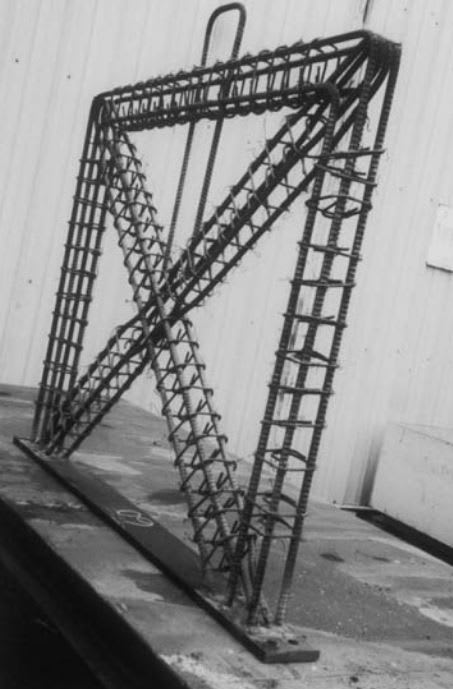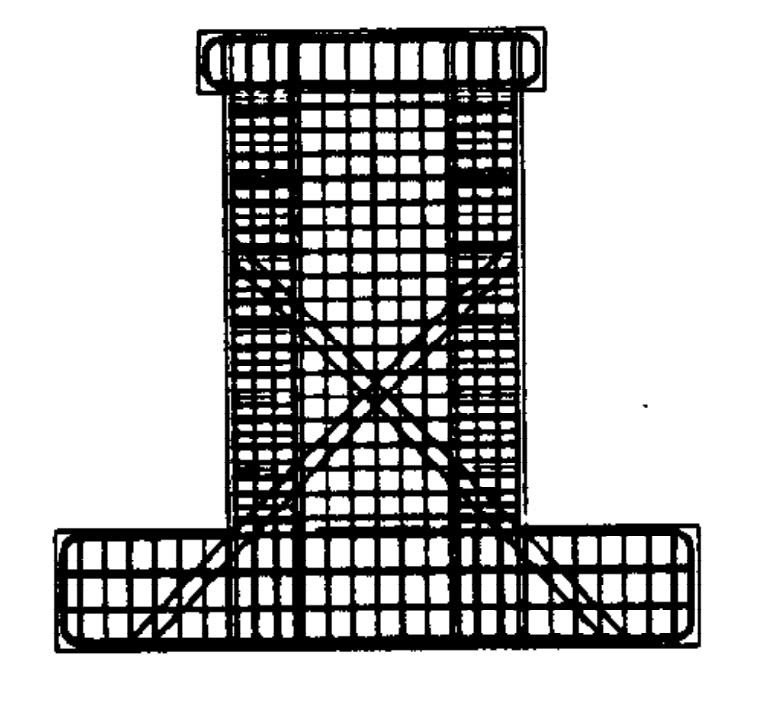Navigation
Install the app
How to install the app on iOS
Follow along with the video below to see how to install our site as a web app on your home screen.
Note: This feature may not be available in some browsers.
More options
Style variation
-
Congratulations TugboatEng on being selected by the Eng-Tips community for having the most helpful posts in the forums last week. Way to Go!
You are using an out of date browser. It may not display this or other websites correctly.
You should upgrade or use an alternative browser.
You should upgrade or use an alternative browser.
Diagonal Reinforcement bars for Shear Walls
- Thread starter civeng80
- Start date
- Status
- Not open for further replies.
- Thread starter
- #3
Yes that is what I mean. After all isn't this an application of the strut and tie method of design. If the concrete is destroyed at ultimate load, then the bracing ties should then become active ? But in fact I beleive they will become active long before ultimate conditions. Any thoughts ?
Interesting question. When they test these things, they tend to set things up in a way that nicely skirts your very practical anchorage concern. I'd think that you'd have to do one of two things:
1) Have diagonal starters coming out of the foundation which seems like a constructability nightmare or;
2) Deliver the loads to some manner of "in-wall" sill beam and then connect that to the foundation more conventionally.
I'm inclined to steer clear of this arrangement for seismic applications precisely because of these concerns. I'm not sure if the real world details have really been thought through and/or tested in a way that makes the wall ductility sufficiently predictable under cyclic plastic strains. That, and we have well developed squat wall provisions which would generally lead to more conventional rebar disposition.


I like to debate structural engineering theory -- a lot. If I challenge you on something, know that I'm doing so because I respect your opinion enough to either change it or adopt it.
1) Have diagonal starters coming out of the foundation which seems like a constructability nightmare or;
2) Deliver the loads to some manner of "in-wall" sill beam and then connect that to the foundation more conventionally.
I'm inclined to steer clear of this arrangement for seismic applications precisely because of these concerns. I'm not sure if the real world details have really been thought through and/or tested in a way that makes the wall ductility sufficiently predictable under cyclic plastic strains. That, and we have well developed squat wall provisions which would generally lead to more conventional rebar disposition.


I like to debate structural engineering theory -- a lot. If I challenge you on something, know that I'm doing so because I respect your opinion enough to either change it or adopt it.
- Thread starter
- #5
Thanks Kootk, I see you put a bit of thought into this and thanks for the great pictures. I was thinking only of wind loads and not seismic loading. Where panels are acting as shear walls on the end walls and where 20mm (3/4 in) rods would be sufficient to resist the loads.
Ah, now I get what you're proposing.
- I'd think that anchorage of the rods by ACI app D would be prudent.
- As mjkkb2 mentioned, I think that this scheme may not be compatible with expected behavior. Your rods won't do much until the thing racks in shear enough to elongate them significantly. And, by the tie that happens, your wall would pretty much all ready be destroyed. You might improve this by post tensioning your rods but it's pretty hard to imagine that being cost competitive compared to other alternatives.
- A more constructable arrangement would be to use the concrete as your diagonal and the steel rod as your vertical. Effectively, this is what the squat wall shear design provisions that I mentioned already to.
I like to debate structural engineering theory -- a lot. If I challenge you on something, know that I'm doing so because I respect your opinion enough to either change it or adopt it.
- I'd think that anchorage of the rods by ACI app D would be prudent.
- As mjkkb2 mentioned, I think that this scheme may not be compatible with expected behavior. Your rods won't do much until the thing racks in shear enough to elongate them significantly. And, by the tie that happens, your wall would pretty much all ready be destroyed. You might improve this by post tensioning your rods but it's pretty hard to imagine that being cost competitive compared to other alternatives.
- A more constructable arrangement would be to use the concrete as your diagonal and the steel rod as your vertical. Effectively, this is what the squat wall shear design provisions that I mentioned already to.
I like to debate structural engineering theory -- a lot. If I challenge you on something, know that I'm doing so because I respect your opinion enough to either change it or adopt it.
- Thread starter
- #7
Maybe (not). If that is the case then it should also happen to the shear walls in the pictures. Tension in concrete is resisted by the bars cmpression is resisted by the concrete, its just an application of the strut and tie design method as I see it.
civeng80 said:If that is the case then it should also happen to the shear walls in the pictures.
A few things to consider with regard to that:
- The second clip is really just bars placed to prevent sliding failure. The primary reinforcing is still, clearly, rectilinear.
- The first clip reinforces the diagonals like columns so may well still substantially represent a concrete diagonal member.
- Don't take this the wrong way but the first clip comes from the text of an author who is a bit of a crack pot. Claims to have discovered some new laws of physics that Newton missed etc. The concept didn't gain any real traction, likely for the reasons discussed above. A few cons and no pros.
civeng80 said:its just an application of the strut and tie design method as I see it.
Then you might consider seeing it in a more nuanced fashion. Not all strut and tie models are created equal. You're not supposed to just slap any old triangle together and call it good. Most strut and tie models imply significant cracking and redistribution but the good ones require as little of that as possible by reflecting the naturally developed state of stress in the concrete. Consider:
1) When concrete shear walls are loaded in the lab, they form diagonal cracks. That suggests a diagonal compression field. So we design squat shear walls assuming that concrete diagonals are the struts.
2) The model that you're implying would be reflective of a wall loaded in shear and somehow developing vertical cracks. Ever heard of that happening, anytime, ever?
I like to debate structural engineering theory -- a lot. If I challenge you on something, know that I'm doing so because I respect your opinion enough to either change it or adopt it.
[blue](Kootk)[/blue]
I'm inclined to steer clear of this arrangement for seismic applications precisely because of these concerns. I'm not sure if the real world details have really been thought through and/or tested in a way that makes the wall ductility sufficiently predictable under cyclic plastic strains.
I'm almost positive I've seen a paper on this somewhere. Will dig around and see if I can find it.
- Thread starter
- #10
Can I ask what the application for this is/was? Random innovation or are you trying to respond to a unique design situation?
I like to debate structural engineering theory -- a lot. If I challenge you on something, know that I'm doing so because I respect your opinion enough to either change it or adopt it.
I like to debate structural engineering theory -- a lot. If I challenge you on something, know that I'm doing so because I respect your opinion enough to either change it or adopt it.
- Thread starter
- #12
KootK,
I design quite a few tilt up warehouses and end wall bracing is always an issue because of openings or windows area or small panels, and so I was thinking about strut and tie being applied to shear walls as a bracing mechanism i.e placing minimum fabric reinforcement for shrinkage and bracing reinforcement for the lateral/shear forces. I only deal in non seismic areas so wind only would the design loads here.
So (I guess) a little bit of Random innovation and also to see how others deal with these structural design problems.
I design quite a few tilt up warehouses and end wall bracing is always an issue because of openings or windows area or small panels, and so I was thinking about strut and tie being applied to shear walls as a bracing mechanism i.e placing minimum fabric reinforcement for shrinkage and bracing reinforcement for the lateral/shear forces. I only deal in non seismic areas so wind only would the design loads here.
So (I guess) a little bit of Random innovation and also to see how others deal with these structural design problems.
- Status
- Not open for further replies.
Similar threads
- Question
- Replies
- 3
- Views
- 2K
- Replies
- 1
- Views
- 2K
- Locked
- Question
- Replies
- 5
- Views
- 2K
- Locked
- Question
- Replies
- 3
- Views
- 4K
- Replies
- 4
- Views
- 3K
